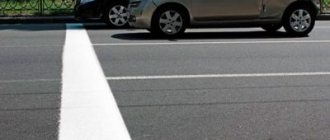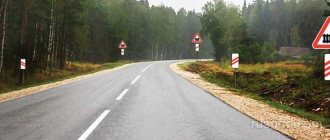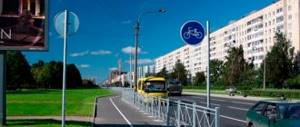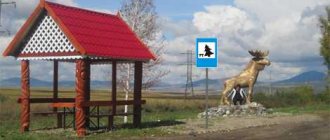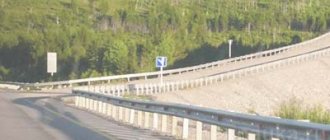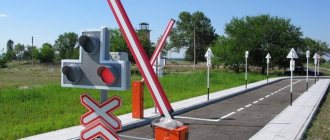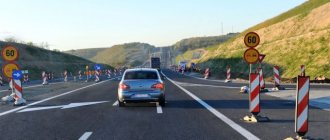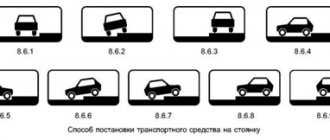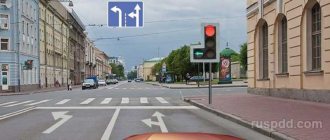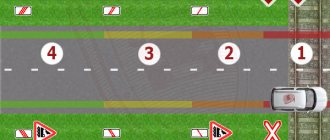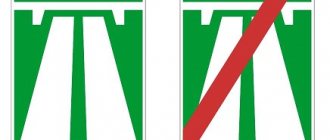These signs warn you that you are approaching:
| 1. | Towards a railway crossing without a barrier. |
| 2. | Towards a railway crossing with a barrier. |
| 3. | To the place of work on the road. |
The main sign “Railway crossing with barrier” outside populated areas is installed at a distance of 150 to 300 m before the crossing, in addition, the same sign is installed again at a distance of at least 50 m before the crossing.
“Approaching railroad crossing” signs provide additional warning that you are approaching a railroad crossing. They are used only outside populated areas.
General information
Cars must give way to this vehicle, as evidenced by signs and signs, but there are also signs that some drivers interpret incorrectly.
At the same time, crossing railway tracks is possible only through a special crossing and subject to the presence of a permitting signal, and violation of this procedure is punishable administratively.
Basic Concepts
To understand the issue of road signs, especially those located in dangerous areas, you should understand what their meaning is and when they are used on public roads.
Familiarization with the basic terms that are used in this area can help with this:
| Concept | Meaning |
| Railroad crossing | A place where railroad tracks and highways or other highways intersect. It is an object of high-risk road infrastructure, therefore traffic lights and barriers are installed on it, which help to avoid an emergency situation |
| Barrier | A barrier bar that controls the entry and exit of vehicles and limits movement in dangerous areas. Available in manual and automatic types, allowing flow control even without human intervention |
| Road sign | A special road safety device that displays a specific picture that provides traffic participants with useful information about prohibitions and permits, and failure to comply with the requirements of the signs is punishable by a fine |
Destination purpose
A driver who sees this sign must not begin overtaking less than 100 meters from the crossing, and must also slow down in order to respond in time to the turning on of a prohibitory traffic light and the appearance of a train.
Some drivers do not like to waste time waiting for a train to pass, so they break the rules and cross the rails; therefore, special road signs are installed to warn them of responsibility.
Therefore, the designation of a railway crossing without a barrier also performs a warning function, urging drivers to be careful.
The legislative framework
The traffic rules state what information this sign carries, but responsibility for violating its requirements is laid down in another legal act.
In addition, GOST 52289-2004 provides the best information on the rules for creating a sign for a railway crossing without a barrier.
For example, its article 12.10 states that violating the passage of a railway passage by ignoring prohibiting signals, a closed barrier or a gesture from an attendant is punishable by a fine or deprivation of rights, as well as stopping in front of a railway crossing without a barrier closer than 50 meters or parking on the tracks.
There is article 12.15, which establishes liability for overtaking at a railway crossing.
Can you outrun a tractor?
| 1. | No. |
| 2. | Yes. |
| 3. | Yes, if overtaking is completed 100 m before the crossing. |
Overtaking is prohibited at railway crossings and closer than 100 m in front of them. Since the railway crossing is located outside the populated area, the signs “Railway crossing without a barrier” and “Approaching a railway crossing” are installed at a distance of 150-300 m before the crossing. Therefore, you can start overtaking the tractor in this situation if the overtaking is completed 100 m before the crossing.
Warning road signs 1.1-1.4.6
Last update: 03/27/2020 No comments
- Warning road signs
- Warning road signs 1.1-1.4.6
- Warning road signs 1.5-1.10
- Road signs 1.11.1-1.12.2 “Dangerous turns”
- Road signs 1.13 “Steep descent” and 1.14 “Steep ascent”
- Warning road signs 1.15-1.20
- Warning road signs 1.21-1.25
- Warning road signs 1.26-1.30
- Warning road signs 1.31-1.34.3
- Warning sign 1.35 "Intersection area"
In this part, we will consider a group of warning road signs for railway crossings: “Railway crossing with a barrier”, “Railway crossing without a barrier”, “Single-track railway”, “Multi-track railway” and “Approaching a railway crossing”.
Sign 1.1 “Railway crossing with barrier”
Road sign 1.1 “Railway crossing with a barrier” warns drivers about approaching a railway crossing that is equipped with a barrier.
Outside a populated area, sign 1.1 is installed at a distance of 150-300 m, in a populated area - at a distance of 50-100 m. The sign can also be placed at a different distance, and the sign is used with the sign 8.1.1 “Distance to the object”.
Sign 1.2 “Railway crossing without barrier”
Road sign 1.2 “Railway crossing without a barrier” warns drivers about approaching a railway crossing without a barrier.
Outside a populated area, sign 1.2 is installed at a distance of 150-300 m, in a populated area - at a distance of 50-100 m. The sign can also be placed at a different distance, and the sign is used with a sign 8.1.1 “Distance to the object”.
Outside the populated area, the signs “Railway crossing with a barrier” and “Railway crossing without a barrier” are repeated. A repeat sign is placed at a distance of 50 - 100 meters before the crossing.
Signs are duplicated on the left side of the road if the visibility distance of a crossing outside populated areas is less than 300 m, and in a populated area the visibility distance of a crossing is less than 100 m.
It happens that two railway crossings in a row are located at some distance from each other. In such cases, if the distance between railway crossings is 50 meters or less, signs 1.1 and 1.2 are installed before the first crossing, and if the distance between them is more than 50 meters - before each crossing.
Sign 1.3.1 “Single-track railway”
Sign 1.3.2 “Multi-track railway”
Signs “Single-track railway” and “Multiple-track railway” are installed in front of all railway crossings without a barrier, across a railway with one or two or more tracks, respectively.
When the crossing is equipped with a traffic light signal, the signs are installed on the same support as the traffic light, and if there is no traffic light, then they are placed at a distance of 6 - 10 meters from the nearest rail.
Signs 1.4.1 - 1.4.6 “Approaching a railway crossing”
These signs serve to further inform drivers about the degree of approach to a railway crossing outside a populated area.
Signs 1.4.1 - 1.4.6 “Approaching a railway crossing” are installed on roads with two or more lanes for traffic in both directions before each crossing, and on roads with one lane - when the visibility distance of the crossing is less than 300 m.
Signs 1.4.1 - 1.4.3 are installed on the right side of the road, and signs 1.4.4 - 1.4.6 - on the left.
Signs 1.4.1 and 1.4.4 (with three stripes) are installed with the first (main and backup) sign 1.1 or 1.2 in the direction of travel, signs 1.4.3 and 1.4.6 (with one stripe) - with a repeated sign 1.1 or 1.2, and signs 1.4.2 and 1.4.5 (with two stripes) - independently, at an equal distance between the first and repeated sign 1.1 or 1.2.
The diagram shows that signs 1.4.1, 1.4.3, 1.4.4 and 1.4.6 are placed under sign 1.1 or 1.2, signs 1.4.2 and 1.4.5 are located between them. They are placed at a height equal to the height of installation of signs 1.4.1, 1.4.3, 1.4.4 and 1.4.6.
Thus, if on your way you come across a combination of signs 1.1 “Railway crossing with a barrier” or 1.2 “Railway crossing without a barrier” with signs 1.4.1 or 1.4.4 (with three inclined stripes), then before the railway crossing you There is a minimum of 150 and a maximum of 300 meters left.
It immediately becomes clear (from the image on the sign) which railway crossing is ahead - with or without a barrier. Accordingly, it makes sense to pay attention to the organization of passage through the railway tracks, and be prepared, if necessary, to stop at the place established by the traffic rules.
Considering the speed of the car, you can drive directly to the crossing very quickly. I recommend the article (answer to the question) Stop line before a railway crossing.
What is prohibited at a railway crossing and in its immediate vicinity
The rules for driving across railway tracks are described in section 15 of the traffic rules. The main thing to remember is that driving through a railway crossing is prohibited in the following cases:
- when the barrier is closed or beginning to close;
- when there is a prohibiting signal from a traffic light or a crossing officer on duty;
- in case of a traffic jam behind a crossing that will force you to stop on the tracks;
- if a train (locomotive) is approaching within sight.
Overtaking is prohibited directly at the railway crossing and closer than 100 meters in front of it. Overtaking, as you know, involves driving into the oncoming lane.
Therefore, if it turns out that, having reached signs 1.4.1 or 1.4.4 (with three inclined stripes), your car is in the oncoming lane, then it makes sense to have time to move to your half of the roadway before you reach signs 1.4 .2 and 1.4.5 (with two inclined stripes).
In addition, it is prohibited to drive around vehicles standing in front of a closed barrier into oncoming traffic.
Immediately after a railway crossing, overtaking is permitted unless there are other restrictions for this maneuver.
Stopping, turning and reversing are prohibited at railway crossings. Parking is prohibited closer than 50m from railway crossings, the ban applies to both sides of the crossing, but stopping the car in this interval is allowed (see the term Stopping).
A complete list of warning road signs is in Appendix 1 of the Traffic Regulations.
Author: Sergey Dovzhenko Last edition: 03/27/2020
Source: avtonauka.ru
These signs warn you:
| 1. | About approaching a railway crossing with three tracks. |
| 2. | About the presence of a railway crossing without a barrier in 150-300 m. |
| 3. | About the presence of a railway crossing in 50-100 m. |
In front of you is a sign for a railway crossing without a barrier. The sign “Approaching a railway crossing” with three stripes installed underneath is only an additional warning about approaching the crossing. Outside populated areas, this combination of signs is installed at a distance of 150 to 300 m before the crossing.
Highlights
Railroad crossings must be equipped with special technical devices that notify drivers of the approaching train and block their path.
Photo: road signs indicating approaching a railway crossing
Crossings can be regulated, and as a result, equipped with traffic lights, barriers and sound sirens, or unregulated, which means the driver needs to independently monitor the presence of a train.
By the way, the latter are preserved only in places with very low traffic intensity outside the city, while in populated areas and on busy arteries there are only equipped zones.
Thus, if a driver violates the rules and drives through a prohibiting signal, or when the barrier is lowered, he will face a penalty or a ban on driving vehicles.
Basic Concepts
To understand what rules apply in terms of using railway crossings, you should familiarize yourself with the basic concepts in force in the field, which will allow you to understand how railway crossings work, what is prohibited to do on them, and also how to properly cross the crossing.
| Term | Meaning |
| Railway crossing | A specially equipped and equipped area that serves for the safe crossing of rails, does not allow a train to collide with a car, and also notifies drivers in advance of the need to stop and let the train pass. |
| Traffic light | Signaling equipment that tells drivers to stop, allows them to move, and warns them when signals change. In most cases, it is on the basis of traffic lights that traffic at intersections is regulated |
| Barrier | A special traffic limiter in the form of a barrier that does not allow cars to pass and forces them to stop exactly at the distance from the rails that can be considered safe |
| Anti-ramming device | A special technical device that extends out of the ground and prevents vehicles from passing, acting as a barrier. Most often, such mechanisms are automatic and will not work if a car is standing on them, so their activation is absolutely safe for transport |
What does the traffic regulations say?
In addition, the Traffic Rules absolutely prohibit overtaking in a zone 100 meters from the crossing, and cars should only move in one row, unless markings allow otherwise, or a special road sign indicating the number of lanes is installed.
The traffic rules also state that cars should enter the crossing only when the driver is confident that the maneuver will be completed without stopping, and if this happens, then they should leave the crossing as quickly as possible to avoid an accident.
These rules also explain to drivers that parking is prohibited in a zone of 50 meters from the crossing in both directions, unless it is caused by a malfunction or accident, but even in this case, the driver must take all actions that will not allow cars to crash into a standing vehicle, and the car will not interfere with traffic.
The legislative framework
They talk not only about crossings, but also about roads in general, parking and stopping rules, as well as priority when passing through intersections and situations in which it is necessary to give way.
By the way, train traffic is not regulated by traffic rules; instead, there are other standards developed by the railway management.
By the way, in its article 12.10 the issue of crossings is covered most fully, and after reading the information from the document, one can draw a conclusion about what can be done at a crossing, and what should in no case be allowed for safety reasons or under threat of a fine.
And for service personnel, Rules for the operation of railway crossings in the Russian Federation have been developed, which are not very necessary for an ordinary driver.
What signs are installed immediately before a railway crossing?
| 1. | Only A. |
| 2. | Only B. |
| 3. | Only in. |
| 4. | A and B. |
Answer
| Sign B “Multi-track railway” is installed closest to the railway crossing. It is placed in front of railway crossings without a barrier on the same support as traffic lights, and in their absence, at a distance of at least 20 m from the nearest rail. |
| Signs A “Railway crossing with a barrier” and “Approaching a railway crossing” are installed only on roads outside populated areas at a distance of at least 50 m from the dangerous area. |
| Signs B “Railway crossing without a barrier” and “Approaching a railway crossing”, respectively, 150-300 m before it. |
The correct answer is Only B.
Friday, April 25, 2014
TICKET No. 37 – Tickets for the traffic rules exam with comments and illustrations (CD and C1D1)
Which of the following signs are installed immediately before a railway crossing?
1. Only A 2. Only B 3. Only C 4. A and C
You are allowed to make a U-turn:
1. Only along trajectory A 2. Only along trajectory B 3. Along any trajectory from those indicated
Can you park your car behind the overpass?
1. Possible 2. Possible no closer than 5 m from the overpass support 3. No
A situation in which the driver of a vehicle moving in the right lane is required to give way when changing lanes is shown:
1. On the left picture 2. On the right picture 3. On both pictures
Is it prohibited to overtake on bridges, overpasses, overpasses and under them?
1. Prohibited 2. Prohibited only under bridges, overpasses and overpasses 3. Prohibited only if there is a continuous marking line 4. Allowed
Can you stop in the tunnel to pick up a passenger?
1. You can. 2. You can only travel by small bus. 3. It is impossible.
What should you do when turning right?
1. Stop in front of the stop line and, having let pedestrians through, turn right 2. Having entered the intersection, stop in front of the pedestrian crossing to let pedestrians through 3. Continue driving without stopping at the intersection
When moving in which direction will you have an advantage?
1. Only when turning right 2. Only when turning left 3. In any direction listed
You intend to continue straight ahead. Your actions:
1. Pass the intersection first 2. Give way to the tram
On which sections of the highway is it prohibited to drive in reverse?
1. Only at points of entry or exit from it 2. Only at places where route vehicles stop 3. Along the entire length of the road
Moped drivers are prohibited from turning left or turning around:
1. Only when driving on a road with tram traffic 2. Only when driving on a road that has more than one lane for traffic in a given direction 3. In both of these cases
Which driver violated the parking rules?
| 1. | Both did not violate. |
| 2. | Both violated. |
| 3. | Only the driver of car B. |
| 4. | Only the driver of car A. |
Both drivers violated the Rules, since parking is prohibited within 50 m on either side of railway crossings.
Signs before railway crossing
Accidents at railroad crossings are more common than many people realize. For example, in 2021 there were 260 terrible accidents involving a train.
Dear readers! The article talks about typical ways to resolve legal issues, but each case is individual. If you want to find out how to solve your particular problem , contact a consultant:
+7 (Saint Petersburg)
APPLICATIONS AND CALLS ARE ACCEPTED 24/7 and 7 days a week.
It's fast and FREE !
Compared to the number of collisions on the roads, this is small, but a meeting with a freight or passenger train leaves no chance of survival.
To prevent road accidents, signs are installed when approaching railway crossings. They are studied in driving school, and every driver is required to know the symbols.
Is such a maneuver allowed?
| 1. | No. |
| 2. | Yes, if there are no oncoming vehicles. |
| 3. | Yes, if the distance between the barrier and a stopped truck is 6 m. |
The driver of the truck stopped in accordance with the requirements of the Rules - no closer than 5 meters from the barrier, and passing vehicles standing in front of the crossing into oncoming traffic is prohibited.
Travel rules
Let's look at the basic traffic rules that apply to crossing railway crossings:
| №12.4 | Stopping on railway tracks is prohibited. This applies not only to parking, but also to short stops. It is also prohibited to disembark passengers on the tracks |
| №15.3 | It is prohibited to cross a crossing if there is a traffic jam behind it. This will force the driver to stop on the railway tracks, which is unsafe |
| №12.5 | It is prohibited to park a car at a distance of less than 50 meters before the crossing |
To begin with, we note that a forced stop refers to a stop that occurred through no fault of the driver. For example, if the car breaks down or the vehicle in front makes an emergency stop.
In this case, you need to act according to the rules:
- disembark passengers and evacuate them to a safe distance from the railway tracks;
- send one person in both directions along the rails to signal to the train that the crossing is not clear (waving a red rag or a flashlight);
- stay near the vehicle and sound the alarm;
- when a train appears in the visibility zone, run towards it (along the rails, not along them) and give a signal);
- notify the duty officer about the incident.
Failure to comply with these rules not only threatens with severe punishment from the traffic police, but can also cause a serious accident with casualties.
With a STOP sign
A STOP sign means that the driver must stop and make sure it is safe to continue. It is installed in close proximity to the railway crossing. But it does not always mean that the driver must stop.
So, if the crossing is unregulated, then the driver must stop in front of the sign and make sure that the train is not approaching the crossing. Failure to stop is considered a violation.
If the red light comes on, then stopping is mandatory. If there are no prohibiting signals, then stopping is not necessary.
With a working traffic light
According to traffic rule No. 15.3:
You cannot drive onto the railway track when the barrier is lowered or is already lowering; Driving at a red traffic light is prohibited; the position of the barrier does not matter; you cannot cross a railway crossing with a special signal from the duty officer (hands raised up or holding a baton, flashlight, flag); if a train is approaching the crossing within sight, regardless of the working signals.
It is also prohibited:
- overtake a vehicle in front and enter the oncoming lane;
- open the barrier independently, even if there is no train in sight;
- transport special-purpose equipment through the crossing in tow;
- without the permission of the duty officer, cross the crossing in slow-moving vehicles at a speed below 8 km/h.
